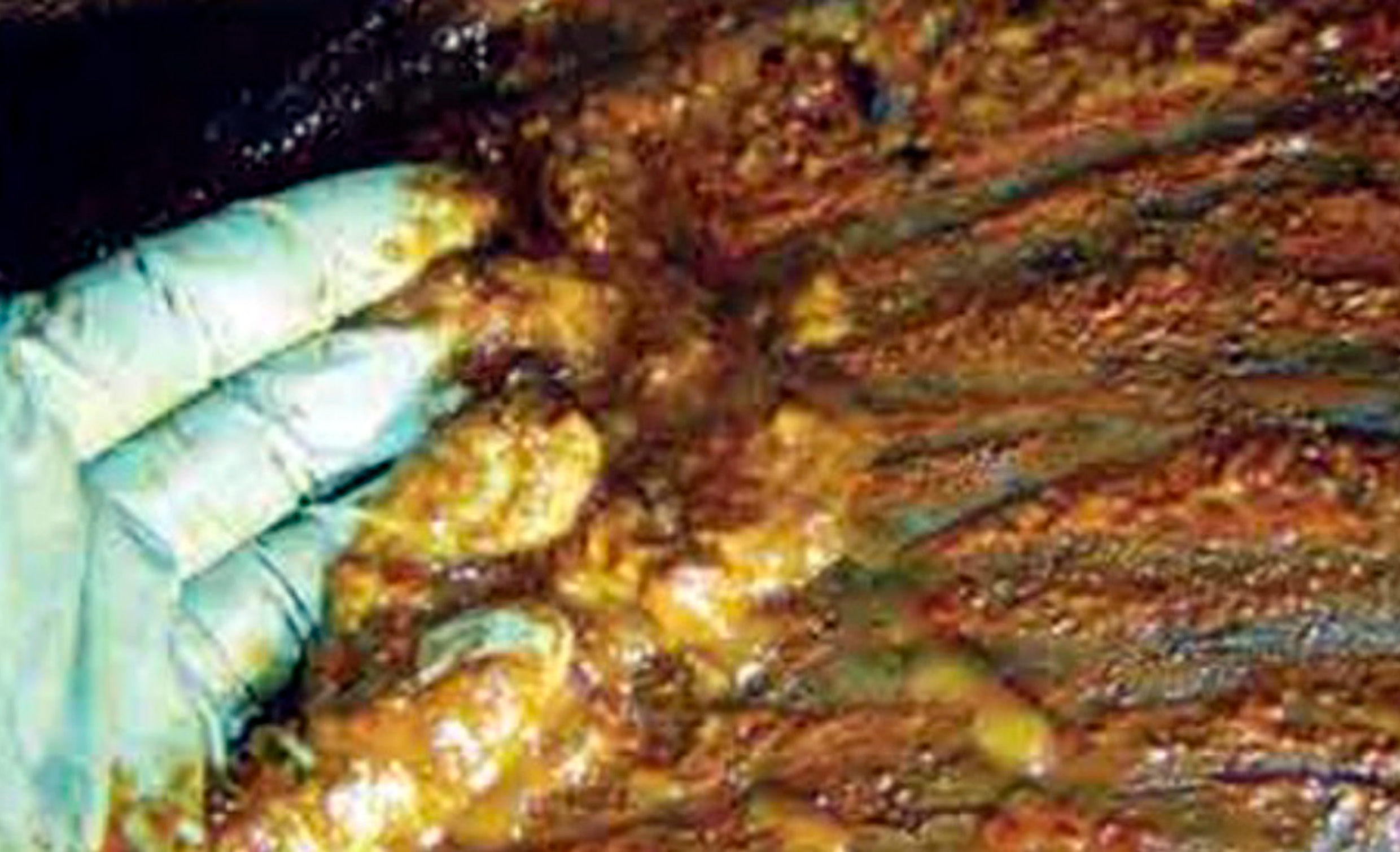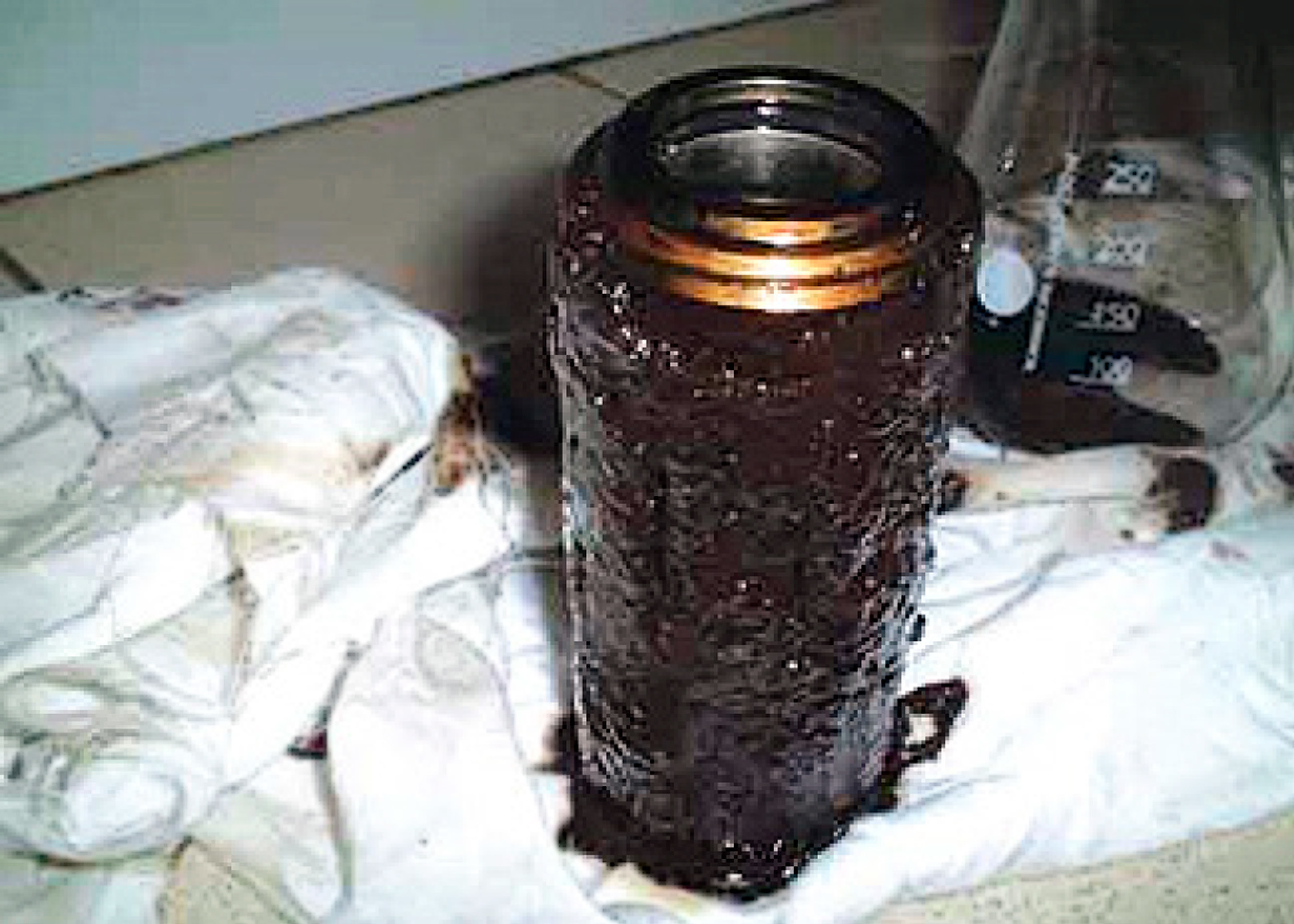Varnish formation is a huge problem in areas with high temperatures combined with high moisture, as for example in the Middle East, South Asia and South America.
The combination of water, particles, and high temperatures increases the risk of varnish generation, which can cause interruptions of the production such as tripping system and production loss. Once varnish deposits are generated in your system, it is very difficult to eliminate the deposits.
What Causes Varnish Formation?
Varnish is caused by oil degradation. In time oil degradation will result in, what people refer to as, insolubles in the oil, which is the initial stage of varnish formation.
If this development is left unattended, the insolubles will react with solid wear particles in the system and generate varnish.

Example of soft varnish.
The main causes of oil degradation are oxidation (oxygen), hydrolysis (water) and thermal degradation (high temperature). In many cases it is a combination of all three causes in common with internal or external contamination, which cause oil degradation.
- Oxidation: Oxidation is the reaction of materials with oxygen. It leads to insoluble products (sludge) that may precipitate as a thin film, forming lacquers or varnish deposits on hot or cold metal surfaces.
- Hydrolysis: Hydrolysis is the reaction of materials with water. Water in the oil can be generated as condensed water from the atmosphere.
- Thermal degradation: Thermal degradation is a breakdown of the oil activated by heat/high temperatures. Typically thermal degradation occurs in hot spots of the system.
- Internal or external contamination: The presence of foreign substances in the oil has a great influence on oil degradation. Metals such as copper and iron are catalysts to the degradation process.
Are you aware of...
...that varnish only can be seen with the naked eye, when the oil temperature gets below approximately 45°C?
Additives Can Cause Creation of Varnish
Oil degradation is accelerated in areas with:
- High moisture leading to ingress of water in the lubricant system.
- High operating temperatures of the oil, and/or
- Big temperature differences causing condensing problems.
To prevent or postpone oil degradation under such tough conditions, the oil will often be supplemented with special additive packages consisting of a high level of phosphor, calcium and zinc. These additive packages are extremely effective in preventing degradation processes of oil, but unfortunately, nothing last forever.
In time, it is unavoidable that the additives will get worn out, which especially can be caused by contact with water and contamination of solid particles in the oil.
The worn out additives are falling out as microscopic particles with a size below 1 micron.

Varnish clogging
Symptoms of Oil Degradation
An oil degradation process can be identified by the following symptoms:
- Increased viscosity: Increased viscosity of the oil will result in friction, wear and loss in system efficiency.
- Decrease of flash point: Fresh oil has a flash point at 202°C, which will decrease in case of degradation. A flash point lower than 180°C can pose a safety risk and require immediate action.
- Change in the acid (TAN) neutralization value: Oil degradation will result in formation of acidic compounds, which promotes corrosion, for example pitting. This leads to increased wear in the internal surfaces of the attacked system.
- Decreased additive performance: Additives react with the degrading products such as water and solid particles, which lead the additives to loose their effect.
- Varnish formation: Varnish deposits are “sticky” and will trap hard contaminants and create a “sandpaper surface”, which will accelerate component wear. In addition, varnish can result in blocking filters and valves and clogging orifices. Varnish does acts as an insulator, reducing the effect of heat exchangers, resulting in higher temperatures and accelerated reaction speeds.
- Increased contamination level: Presence of unwanted particles and/or fluids in the oil.
Consequences of Varnish and Oil Degradation
The consequences of varnish formation and oil degradation are many; below mentioned are some of the most severe:
- Shorter lifetime of the oil.
- Reduced oil performance, loss of lubricity, valve failure and restricted oil flow.
- Reduced productivity, 'Monday'-problems/slow start-ups, increased downtime and reduced system performance.
- Higher energy consumption due to friction and wear.
- Increased maintenance costs, increased filter change frequency, increased wear on components, acidic corrosion of metallic components, component failures and cleaning of oxidation deposits.
- Environmental pollution consequences, leakages and greater disposal costs of oil and filter changes.
Known Actions toward Varnish Elimination
A known method to eliminate varnish is to establish a kidney loop and hereby perform electrostatic filtration, electro physical bonding or offline filtration of the infected system.
Unfortunately, these methods are limited by low flow conditions at less than 50 litres/minute, which will not always be effective enough to eliminate varnish at the same rate as it is generated in the system. In such cases, the normal procedure is to shut down the whole system and clean it manually in order to eliminate the varnish formation. Such a cleaning process will involve the following steps:
- Shutdown of the infected system.
- Draining of the system for all infected oil.
- Mechanical cleaning of the oil tank.
- Filling and filtering of new oil to the system.
- Conduction of a full system flushing.
All together this is a very expensive and time consuming procedure, which will result in huge production losses at the infected system.
Source Treatment rather than Symptom Treatment
Instead of waiting to take action until the varnish is causing problems in the system, IKM Ocean Team focuses on eliminating the catalysts for varnish formation before they start causing interruptions of the general production.
On the basis of oil analyses, we are able to monitor the oil degradation process and apply an on-line solution.
The IKM Ocean Team solution is patented and proved.